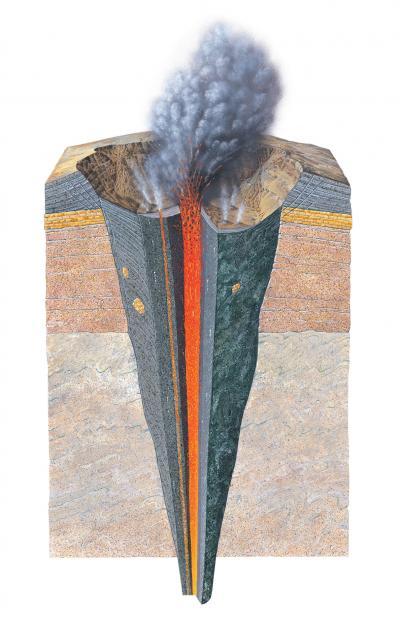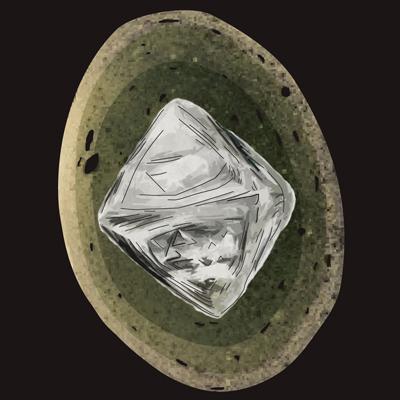A previously unrecognized volcanic process similar to one used in chocolate manufacturing is important in the dynamics of volcanic eruptions. 'Fluidised spray granulation' is a type of gas injection and spraying process used to form smooth coatings on confectionaries but it can also occur during kimberlite eruptions to produce well-rounded particles containing fragments from the Earth's mantle - most notably diamonds.
Kimberlite volcanoes are the primary source of diamonds on Earth, and are formed by gas-rich magmas from mantle 75 miles beneath the surface. Kimberlite volcanism involves high-intensity explosive eruptions, forming diverging pipes or 'diatremes', which can be several hundred meters wide and several kilometers deep. A conspicuous and previously mysterious feature of these pipes are 'pelletal lapilli ' — well-rounded magma coated fragments of rock consisting of an inner 'seed' particle with a complex rim, thought to represent quenched magma.

Artistic impression of a late-stage erupting kimberlite melt piercing through older pyroclastic deposits in the diatreme. Credit: Gary Hincks, www.garyhincks.com
These pelletal lapilli form by spray granulation when kimberlite magma intrudes into earlier volcaniclastic infill close to the diatreme root zone. Intensive degassing produces a gas jet in which the seed particles are simultaneously fluidised and coated by a spray of low-viscosity melt. In kimberlites, the occurrence of pelletal lapilli is linked to diamond grade (carats per tonne), size and quality, and therefore has economic as well as academic significance.
Dr Thomas Gernon, Lecturer in Earth Science at the University of Southampton, says, "The origin of pelletal lapilli is important for understanding how magmatic pyroclasts are transported to the surface during explosive eruptions, offering fundamental new insights into eruption dynamics and constraints on vent conditions, notably gas velocity.
"The ability to tightly constrain gas velocities is significant, as it enables estimation of the maximum diamond size transported in the flow. Gas fluidisation and magma-coating processes are also likely to affect the diamond surface properties."

Kimberlite volcanoes, the primary source of diamonds, contain enigmatic magma-coated clasts; pelletal lapilli. These are generated deep in the volcanic vent by a granulation process analogous to that commonly used in coating chocolates, drugs and fertilizers. Credit: University of Southampton
Gernon and colleagues studied two of the world's largest diamond mines in South Africa and Lesotho. In the Letseng pipe in Lesotho, pelletal lapilli have been found in association with concentrations of large diamonds (up to 215 carat), which individually can fetch up to tens of millions of pounds. Knowledge of flow dynamics will inform models of mineral transport, and ultimately could improve resource assessments.
Published in Nature Communications.




Comments